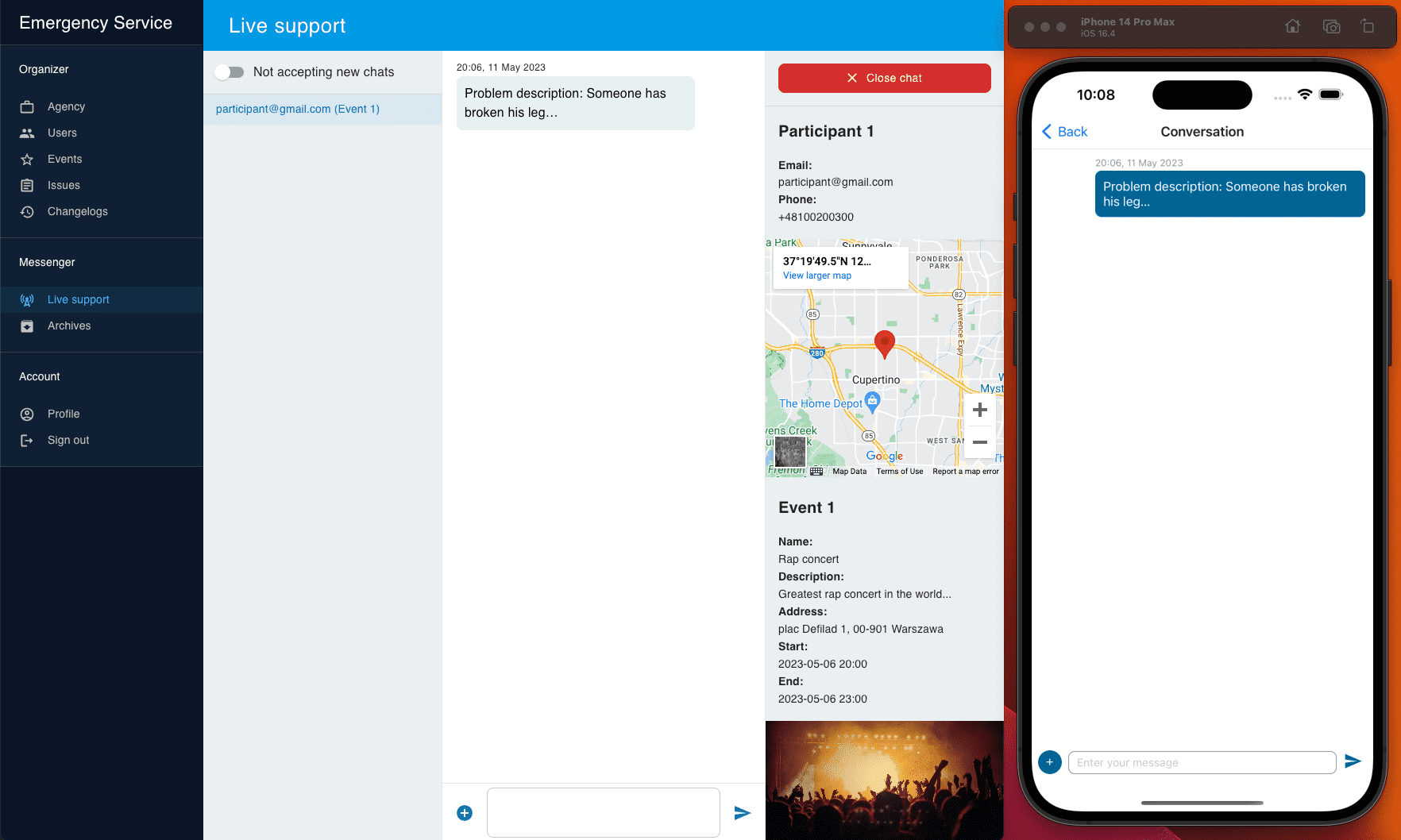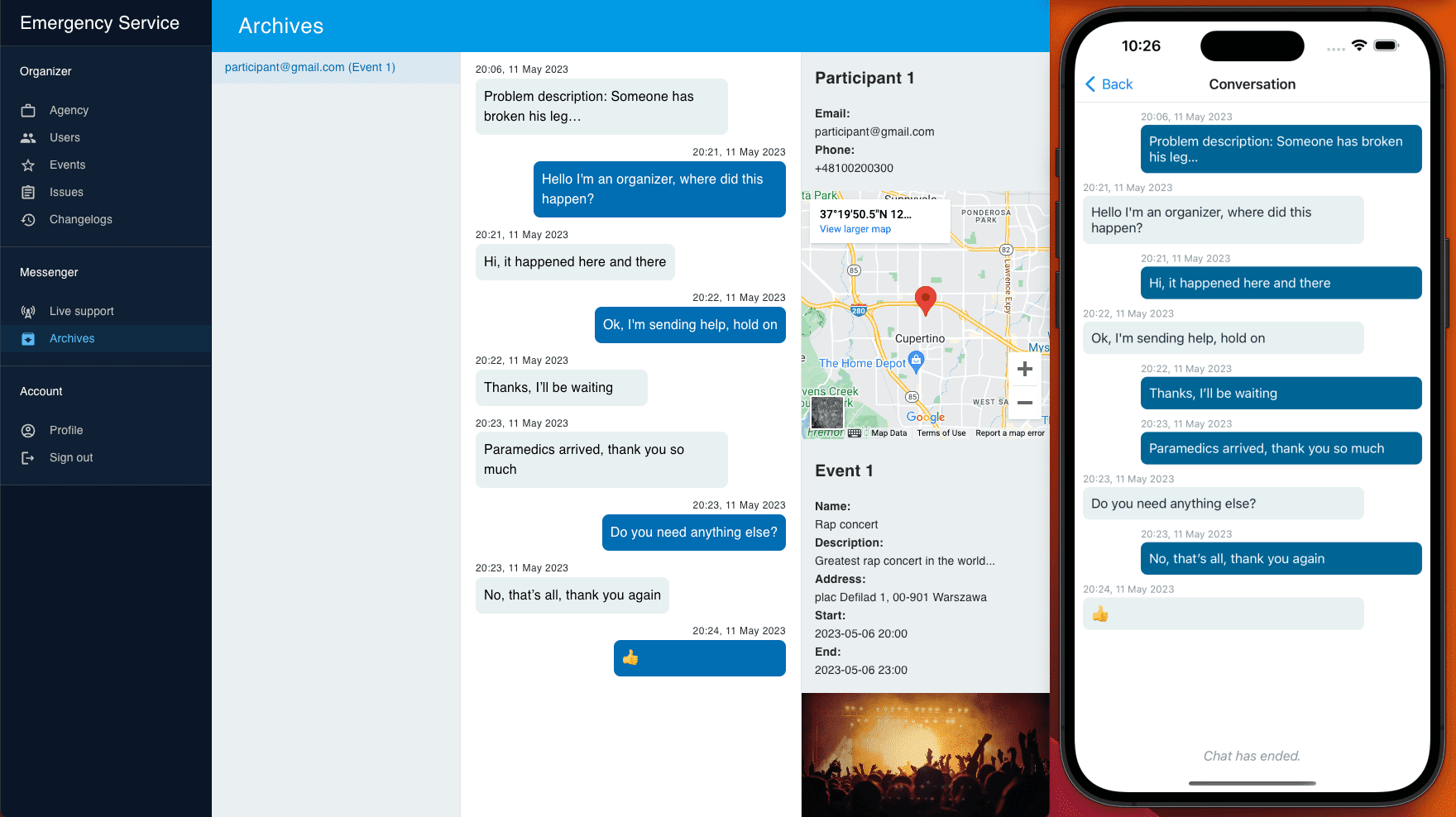Chats and messages
If organizer is waiting for a new chat and there is a chat request in agency's queue, chat starts for both the organizer and participant with problem description sent as the first message from the participant.
Frontend
For better user experience, receiving a message, resizing the window or opening software keyboard on mobile devices automatically scrolls the messages window to the last message.
If participant shares the location of his device, Organizer UI shows iframe with Google Maps centered at the participant location coordinates rounded to 5 significant digits (rounding adds uncertainty of 1.11 meters). The location is saved with every participant's message and the Google Maps iframe is refreshed if the rounded coordinates change in the next message.

When the organizer is sure the case is resolved and chat is no longer needed, he can use the Close chat button to end it and move it to Archives section for both parties. After the chat has ended, no more messages can be sent to it and the chat input is hidden in both user interfaces. Closing chat releases the participant's lock on requesting help on the associated event so he can later request another chat on the same event.

Mobile chats screen displays both active and archived chats and distinguishes them by bolder font and green badge for the active chats. The list of chats is split by the activity status (active first) and each group is sorted by the start time (newest first).

What is more, if the WebSocket connection is interrupted on the frontend, both Organizer and Participant UIs are
automatically reconnecting every 5 seconds using React useEffect hook and JavaScript setInterval:
useEffect(() => {
if (messenger.hasState() && !messenger.isConnected()) {
const restartInterval = setInterval(
() => messenger.connect(
authorizationHeader,
dispatch,
alertStore
),
restartIntervalTime
)
return () => clearTimeout(restartInterval)
}
}, [messenger.hasState(), messenger.isConnected()])
The messenger object in the above code is an instance of a class managing client WebSocket connection to
Messenger API. It additionally uses authorization header to authenticate, integrates dispatch function from
useReducer hook handling incoming messages from the server and signals connection errors in the application
alert bar with alertStore object.
To make the WebSocket easily accessible in any React component that needs it, two contexts has been created:
InboxContext and MessengerContext. The first one stores user chats and messages (with participant's
geolocation information in case of Organizer UI) and the latter exposes methods to send WebSocket messages to the
Messenger API.
Backend
Chat protocol
Messenger API uses custom JSON-based chat protocol for incoming and outgoing messages in the form of:
{
"type": <message_type:string>,
"payload": <data:any>
}
The only exception is the first message from client, which is a JSON with authorization header as the browser WebSocket
implementation does not support sending a HTTP header while establishing connection. Authorization is not a
required opening handshake header in the RFC 6455 defining
the WebSocket Protocol.
After successfully connecting to the server, client implementations in React and React Native start with sending the
get_chats and then sending get_chat_history for each returned chat.
Messages to server
| Message type | Data | Users allowed to send |
|---|---|---|
get_chats | none | organizers and participants |
get_chat_history | chat id | organizers and participants |
send_message | chat id and message text | organizers and participants |
start_chat | none | organizers |
close_chat | chat id | organizers |
All users can use send_message action to communicate, but only the organizers have access to
start_chat and close_chat actions to manage their active chats.
Messages to client
| Message type | Data | Users allowed to receive |
|---|---|---|
chats | list of chats | organizers and participants |
chat_history | chat id and list of messages | organizers and participants |
user_message | message | organizers and participants |
new_chat | chat | organizers and participants |
closed_chat | chat | organizers and participants |
WebSocket connections
Single connection handlers
User's connection handler is running in its own goroutine with a for loop reading incoming messages from a specific WebSocket connection of the user and it exposes methods for sending an outgoing message or an error there. To synchronize actions between all connections from the user (they could be from different devices or browser tabs), connection handler uses a Golang channel to push all the messages to the user's connection pool handler.
func (oc *OrganizerConnection) listenOnConnection() {
defer func() {
if r := recover(); r != nil {
oc.logger.Printf("panic %v\n", r)
oc.Close()
return
}
}()
for {
msg, err := oc.read()
if err != nil {
if !oc.handleReadError(err) {
return
}
continue
}
oc.resetReadTimer()
oc.messages <- NewOrganizerMessage(msg, oc)
}
}
func (oc *OrganizerConnection) read() (*protocol.Message, error) {
msg := &protocol.Message{}
return msg, oc.wsConnection.ReadJSON(msg)
}
Multiple user connections
User's connection pool handler exposes thread-safe methods (protected by a mutex) for adding a new WebSocket connection and for outgoing message fan-out to all user connections. Additionally, it uses two goroutines with for loops to listen for incoming messages and to listen for connection shutdowns. When all the user connections are closed, connection pool handler starts a graceful shutdown of itself to free memory. Golang channels and select statements are used to notify and stop hanging goroutines.
func (ocp *OrganizerConnectionPool) listenOnMessages() {
for {
select {
case <-ocp.doneChan:
ocp.logger.Printf(
"stopped listening on messages for %s\n",
ocp.GetInfo(),
)
return
case msg := <-ocp.connectionMessages:
go ocp.consumer.ConsumeMessage(msg)
}
}
}
func (ocp *OrganizerConnectionPool) listenOnShutdowns() {
for {
select {
case <-ocp.doneChan:
ocp.logger.Printf(
"stopped listening on shutdowns for %s\n",
ocp.GetInfo(),
)
return
case conn := <-ocp.connectionShutdowns:
go ocp.removeConnection(conn)
}
}
}
Message consumers
The incoming messages consumers expose a ConsumeMessage method to appropriately handle each message type.
Organizer and participant messages are handled by similar consumers with a few differences in allowed message types and
logic.
func (c *Consumer) ConsumeMessage(msg *connections.OrganizerMessage) {
switch msg.Message.Type {
case in.MsgTypeGetChats:
c.consumeGetChats(msg)
case in.MsgTypeStartChat:
c.consumeStartChat(msg)
case in.MsgTypeSendMessage:
c.consumeSendMessage(msg)
case in.MsgTypeGetChatHistory:
c.consumeGetChatHistory(msg)
case in.MsgTypeCloseChat:
c.consumeCloseChat(msg)
default:
c.logger.Printf(
"invalid message type %s from organizer %d\n",
msg.Message.Type,
msg.Source.Organizer.Id,
)
msg.Source.SendError(common.ErrInvalidMessageType)
}
}
Incoming message consumers use a reference to ChatsManager which coordinates sending outgoing messages to
members of the specific chat and provides in-memory cache with active chats. To ensure that server state is up to date,
initializing a new WebSocket connection goes through the ChatsManager which fetches user chats and then creates
or calls an existing user's connection pool handler to attach a new connection handler. Unfortunately,
this design is stateful and does not allow horizontal scalability because it assumes that all WebSocket connections
communicate with the same chat server keeping all active chats and connection pools.